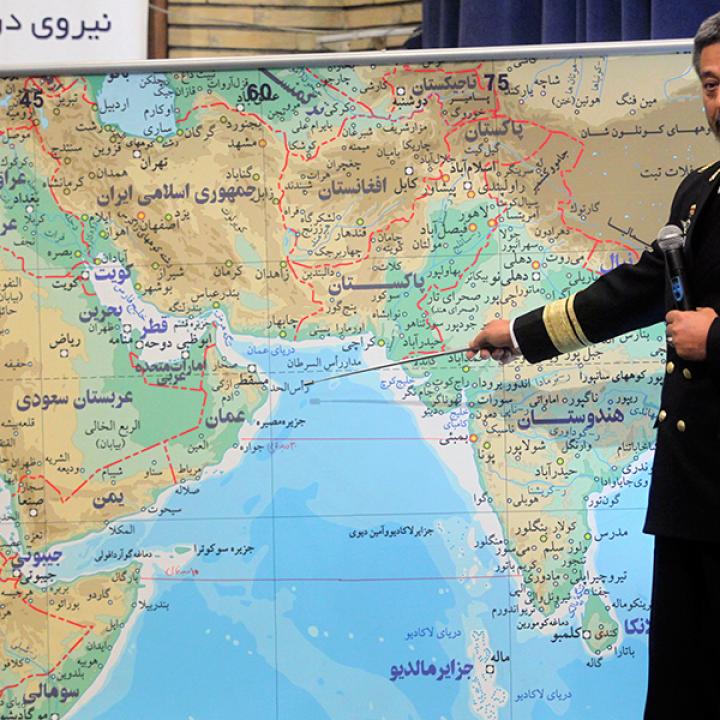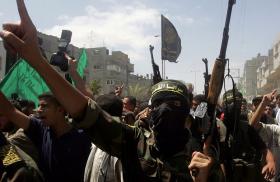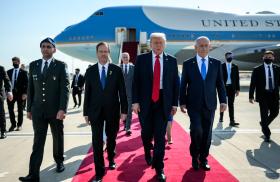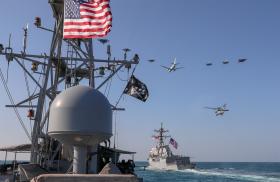

Tehran could back up its defiant rhetoric by deploying air defense assets to Syria, establishing an asymmetric naval presence in the Mediterranean, smuggling more arms to the Houthis, and stepping up its ballistic missile program.
As supporters of the Assad regime contemplate their next moves in Syria, Iran is weighing its options for establishing a permanent foothold in the war-ravaged country. Tehran no doubt hopes to secure a reliable logistical route to southern Lebanon and put more pressure on Israel in the Golan Heights, thereby returning to the preferred mode of "Islamic world vs the Zionist entity," as Gen. Hossein Nejat, acting head of the Islamic Revolutionary Guard Corps (IRGC) intelligence branch, described in an October 20 interview.
Against this backdrop, Maj. Gen. Mohammad Bagheri, the chairman of Iran's Armed Forces General Staff (AFGS), arrived in Damascus on October 17 for a four-day visit during which he met with Bashar al-Assad and discussed future military ties. The meeting took place the day after Israeli jets struck a Syrian SA-5 missile site that had fired on one of their air patrols, spurring Bagheri to denounce the "repeated Israeli air and land intrusions" into Syrian territory as entirely unacceptable. The visit also came mere days after President Trump's confrontational Iran policy speech, raising questions about whether the Islamic Republic will respond to more assertive U.S. rhetoric by taking indirect action in Syria or other regional hotspots. Such action could take several forms.
SENDING AIR DEFENSE ASSETS TO SYRIA
Since Russia seems unlikely to transfer more high-value air defense assets to Syria or keep them in the country indefinitely, Iran may decide to send its own systems there. This would probably take the form of air-transportable air-defense systems that could be used to monitor and possibly counter future Israeli aerial activities in or near Syria. Israel's most recent actions, such as the November 1 airstrike on a joint Syrian-Iranian industrial area in Homs province, could make Iranian deployments even more likely.
The Israeli air force has struck targets in Syria numerous times over the past few years, but these operations rarely require Israeli jets to enter Syrian airspace. Instead, they tend to fire standoff guided weapons from Lebanese airspace, ostensibly to avoid any confusion with Russian aircraft and air defense assets in Syria. In all likelihood, then, any Iranian air defense deployment would involve highly mobile units, which if used effectively by competent operators could put Israeli aircraft in Syrian or Lebanese airspace at risk. Such units would almost surely come from the IRGC, with embedded operators from the national army's Khatam al-Anbia Air Defense Headquarters. On October 22, the acting commander of that headquarters revealed that IRGC officers hold key positions within the outfit.
The IRGC also operates a mix of Russian-made and indigenous mobile air defense systems that cover anywhere from 10 to 75 km depending on the model. If deployed west of Damascus, mobile batteries such as the indigenous Sayyad-2 or the "3rd of Khordad" surface-to-air missile system, which have a claimed range of 75 km, could theoretically create an air defense umbrella over the entire Golan and southern Lebanon up to Beirut. These systems could be even more threatening to Israeli aircraft if properly integrated with the passive detection and tracking systems Iran is known to possess, especially if manned by competent operators.
EXTENDING THE IRGC'S ASYMMETRIC NAVAL REACH
Among the places Bagheri visited while in Syria was the port city of Latakia, perhaps indicating the IRGC's interest in basing speedboats and other naval assets there. From Latakia, Iranian forces could launch clandestine naval operations against Israeli assets in the region, including offshore natural gas fields. Such missions could be conducted in cooperation with Hezbollah's special naval units.
The IRGC has also reiterated its interest in using small submarines in conjunction with unspecified "new and surprising" tactics. Almost no public information exists about the Guards' submarine activities, but given their unconventional mindset toward hardware and tactics, some clues to their potential plans can be found in South America, where Colombian drug cartels have long used homemade mini-submarines and submersibles to transport narcotics to Mexico. With such vessels, the cartels can transport up to eight tons of cargo plus four crew members as far as 5,600 km, embarking on covert voyages that can last up to fourteen days and are difficult to detect from the air.
IRGC Navy Special Forces and Qods Force units could adopt similar tactics to smuggle arms and personnel in the Gulf of Aden, using Iran's established anti-piracy operations in the area as cover. Mini-subs could be employed to transfer Iranian advisors or high-value Iranian arms and ammunition to Yemen's Houthi rebels, especially missile guidance parts and modification kits, antitank missiles, sniper rifles, and man-portable air-defense systems. If Iran intends to continue its suspected covert arms shipments to these rebels, the Houthi-controlled port of Hodeida is only 3,000 km from the nearest IRGC Navy base on the Iranian coast. As recently as October 21, Yemeni fishermen seized an Iranian vessel suspected of carrying arms for Houthis.
With help from Iran, the Houthis and rebel remnants of the old Yemeni navy could also fabricate fiberglass-covered wooden semisubmersibles of their own in as little as thirty days, fielding manned or unmanned versions complete with satellite communications and navigation equipment. Besides running blockades, such vessels could pose a serious threat to maritime traffic, as was the case in February when an unmanned Houthi boat packed with explosives rammed a Saudi frigate, causing casualties and damage.
In addition, some Colombian smugglers use hollow torpedoes that can carry as much as five tons of cargo while being towed 30 meters below the surface and 200 meters behind innocent-looking fishing boats. Such a submersible is almost impossible to detect from the air, and if the towboat is intercepted, the crew can simply cut the cargo loose and retrieve it later using commercial stealth-locating transponders. To be sure, this method yields considerably lower tonnage compared with small cargo ships and dhows, and the constricted shape of the submersible greatly limits the types of equipment that could be smuggled. Yet this scenario is still plausible given the fact that two to five dhows capable of such towing are normally docked at each IRGC naval base and station.
DEFYING THE MISSILE BAN
On October 8, only days before President Trump's Iran policy speech, IRGC commander Maj. Gen. Mohammad Ali Jafari warned that the Islamic Republic would expand its missile program at an even faster pace if Washington designated the IRGC as a terrorist organization, repeating his past threats against U.S. bases in the region. This would likely mean accelerated efforts to develop an intermediate-range ballistic missile capability, which typically involves weapons that can reach between 3,000 and 5,500 km. On October 31, Jafari boasted about Iran's ability to increase the range of its missiles beyond the 2,000 km limit ostensibly set by Supreme Leader Ali Khamenei, with the goal of threatening a wider range of U.S. interests and bases. The recent unveiling of the Khoramshahr ballistic missile made such boasts more tangible, though test launches of that system have fallen far short of its claimed 2,000 km range or failed outright.
An intercontinental ballistic missile capability is a possibility as well, though it would have little deterrent value without nuclear warheads. That would of course mean breaking away from the nuclear deal, which could have immediate diplomatic and military consequences for Iran. As such, Iranian leaders are unlikely to take that risky route in the near term, especially in the absence of an imminent U.S. military threat. Even so, former IRGC commander and current Expediency Council secretary Mohsen Rezaii reminded his colleagues on October 18 that they had to prepare for an inevitable strategic showdown with the United States down the road, so they may be more motivated to take steps toward an ICBM capability.
CONCLUSION
Tehran has officially denounced the Trump administration's decertification of the nuclear deal and more aggressive posture against the IRGC, vowing to continue expanding its missile program and problematic regional activities. U.S. and allied military personnel should therefore prepare to face more capable and probably longer-range Iranian missiles, since even heavy sanctions seem incapable of convincing Tehran to curb the program.
Iran and its foreign proxies are also unlikely to leave Syria; in fact, Tehran may decide to cement its presence there by emplacing mobile air defense systems and a command-and-control infrastructure to challenge Israeli air supremacy. Such measures could put Israeli and Iranian military forces in direct confrontation, with high risk of escalation -- a possibility that the United States needs to prevent at any cost.
Finally, the IRGC Navy might choose to establish a presence on the coasts of Lebanon and Syria in order to challenge Israel, or increase its clandestine efforts to supply the Houthis using boats or submersibles. The United States should therefore take steps to check Iran's asymmetric naval activities beyond the Persian Gulf, perhaps by tailoring its intelligence and surveillance capabilities to watch for specific threats mentioned above while coordinating more closely with regional allies.
Farzin Nadimi is a Washington-based analyst specializing in the security and defense affairs of Iran and the Persian Gulf region.



